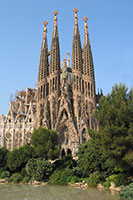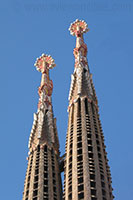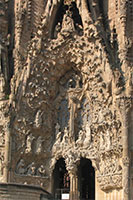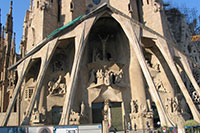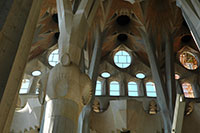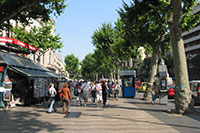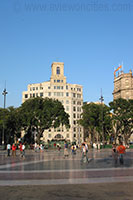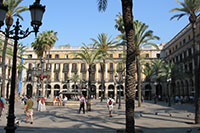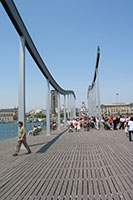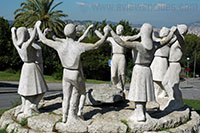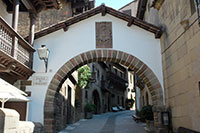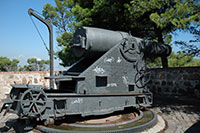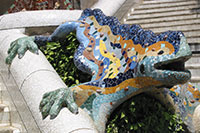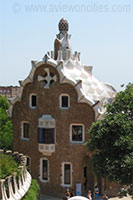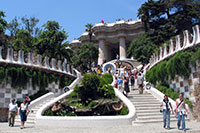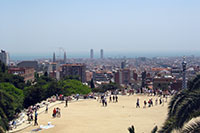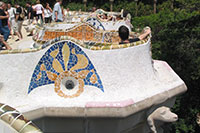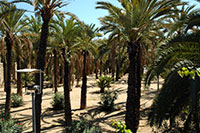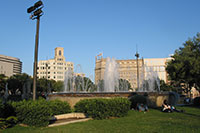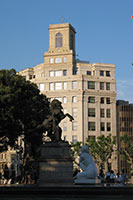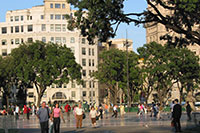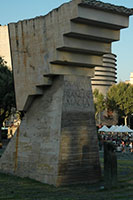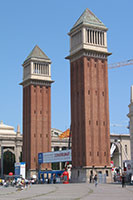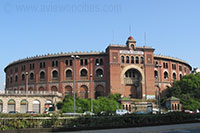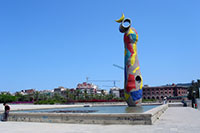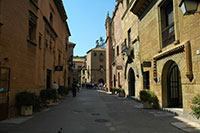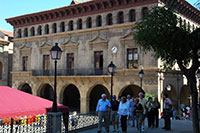
Beijing is a metropolis in northern China and the capital of the People's Republic of China. It is one of the four municipalities of the PRC, which are equivalent to provinces in China's administrative structure. The municipality of Beijing borders Hebei Province to the north, west, south, and for a small section in the east, and Tianjin Municipality to the southeast. Beijing is one of the Four Great Ancient Capitals of China.
Beijing is China's second largest city after Shanghai, with more than 17 million people live in Beijing municipality, a province-level administrative unit with 16 urban and suburban districts and two rural counties; the city's urban area has about 13 million residents. Beijing is a major transportation hub, with dozens of railways, roads and motorways passing through the city. It is also the focal point of many international flights to China. Beijing is recognized as the political, educational, and cultural center of the People's Republic of China, while Shanghai and Hong Kong predominate in economic fields. The city hosted the 2008 Olympic Games.
Few cities in the world besides Beijing have served as the political and cultural centre of an area as immense as China for so long. The Encyclopædia Britannica describes it as, "One of the world's great cities," and declares that the city has been an integral part of China’s history for centuries, there is scarcely a major building of any age in Beijing that doesn't have at least some national historical significance. Beijing is renowned for its opulent palaces, temples, and huge stone walls and gates. Its art treasures and universities have long made the city a centre of culture and art in China.
Badaling Great Wall

Badaling (8 Reaches Ridge) is the best preserved section of the Great Wall. 370 foreign leaders and VIPs have climbed Badaling. It is called Bada (8 Reaches) as the maze of ridges stretch in all directions..
It is located more than 70 kilometers northwest from the center of Beijing City, is more than 1000 meters above sea level, and commands a strategic position on the north passage of Juyongguan (Mediocre House Pass).
The Great Wall at Badaling was built in the 18th year of the reign of the Ming emperor Hong Zhi (1505). The wall, built with tall granite slabs on the outside, is 7.8 meters high on average, some sections even reaching 8.4 meters in height. It is about 6.5 meters wide on average at its base, and 5.7 meters wide on average at the ramparts. The wall is wide enough for five horses to gallop abreast and ten people to advance shoulder to shoulder.
The scenery at Badaling is great in every season. There are sunlit and enchanting scenes in spring and summer, when the valleys covered with greenery. When the rain comes, the view looks vast and hazy. The sky in autumn is high with an unsoiled stratosphere, while the maple forests are golden and red in colour. White snow covers the whole scene in winter.
Beijing Bird Nest

"Bird's Nest", also named the National Stadium, which was the main venue of the 2008 Beijing Olympic Games. It was designed by Pritzker Architecture Prize Gainer Jacques Herzog, de Meuron and Chinese Architect Li Xinggang, shaped as a "bird's nest", and looks like a cradle.
The National Stadium began on December 24, 2003 and was completed in March, 2008. The total construction cost was more than 2.2 billion.
The shape structure of "Bird's Nest" is a colossal saddle-shaped elliptic steel structure with 24 truss pillars in total. It is 333 meters long from north to south, 294 meters wide from east to west, the highest point is 68.5 meters and the lowest point is 42.8 meters. It is the largest world's steel structure. The outside was covered by a sort of membrane, it got the demand of rain-proof, and sunshine can go through transparent roof to satisfy the demand of lawn growing. Bird's NestThis special membrane can also help lighting within the stadium and effectively diminish glare and shadowing, allowing a more favorable competition environment. The design of "Bird's Nest" embodied human caring fully, wherever spectators sit, the sightline is about 140 meters from the centerfield.
The "Bird's Nest" hosted the Opening and Closing Ceremonies, athletic events, and football final of Beijing 2008 Olympic Games which was from August 8 to August 24, 2008 and Beijing 2008 Paralympics from September 6 to September 17, 2008. After the Olympics, the stadium would continue to host international and domestic sporting events, such as football.
The National Aquatics Center "Water Cube"

The National Aquatics Center, also known as the Water Cube, is located on Olympic Green, with the Bird’s Nest Stadium, on Beijing's north-south axis. It was built as the main natatorium for the Beijing 2008 Olympic Games and became known as one of the Games' iconic structures.
Come and marvel at the Water Cube and Beijing's other ancient wonders with an Olympic Memories Tour.
The Water Cube was designed by PTW Architects and Ove Arup. Their unique and inspired design was based on the way soap bubbles come together in a 12 or 14-sided cell structure.
The Water Cube is 177 meters square and 30 meters high, and has a capacity of 17,000 seats (6,000 permanent and 11,000 temporary for the Olympics). During the Olympic Games, it was the main venue for swimming, diving, synchronized swimming and water polo. It is now a multi-functional center for sports, recreation and fitness.
The Forbidden City

The Forbidden City is the best preserved imperial palace in China and the largest ancient palatial structure in the world.
It is recognized as one of the most important five palaces in the world (the other four are the Palace of Versailles in France, Buckingham Palace in the UK, the White House in the US and the Kremlin in Russia). The splendid architecture of the Forbidden City represents the essence and culmination of traditional Chinese architectural accomplishment.
In 1961 the Forbidden City was listed as one of the important historical monuments under the special preservation by the Chinese central government and, in 1987, it was nominated as World Cultural Heritage by UNESCO. The Palace Museum is a real treasure house of Chinese cultural and historical relics.
The Forbidden City, situated in the very heart of Beijing, was home to 24 emperors of the Ming and Qing Dynasties. The construction of the grand palace started in the fourth year of Emperor Yongle of the Ming Dynasty (1406), and ended in 1420. In ancient times, the emperor claimed to be the son of Heaven, and therefore Heaven’s supreme power was bestowed upon him. The emperors’ residence on earth was built as a replica of the Purple Palace where God was thought to live in Heaven. Such a divine place was certainly forbidden to ordinary people and that is why the Forbidden City is so named.
The Forbidden City covers an area of about 72 hectares with a total floor space of approximately 150, 000 square meters. It consists of 90 palaces and courtyards, 980 buildings and 8,704 rooms. To represent the supreme power of the emperor given from God, and the place where he lived being the center of the world, all the gates, palace and other structures of the Forbidden City were arranged about the south-north central axis of Beijing.
The Summer Palace

The Summer Palace, in the Haidian District, northwest of central Beijing, is said to be the best preserved imperial garden in the world, and the largest of its kind still in existence in modern China. It’s hardly surprising that, during the hot Beijing summers, the Imperial Family preferred the beautiful gardens and airy pavilions of the Summer Palace to the walled-in Forbidden City. Dowager Empress Cixi took up permanent residence here for a time, giving rise to some wonderful tales of extravagance and excess.
Although only a short drive (15 km) from central Beijing it seems like another world.
The Chinese call it Yihe Yuan (Garden of Restful Peace), and the landscaped gardens, temples and pavilions were designed to achieve harmony with nature, to soothe and please the eye. The park spreads across the low hills, including Longevity Hill, around Kunming Lake, and was is divided into three main zones (administration, living, and relaxation). The wonderful buildings and courtyards wander beside the lake, along the waterways and climb the low slopes of the hillside. The arched bridges, pretty promenades, decorated ‘corridors’ and breezeways all lead visitors through ever-changing views and scenery. Here the marvelous marble boat, there an old theatre, over there an island reached by small wooden boat, and in the distance the hills, with a temple on the hillside, framed by dark trees. Small wonder that UNESCO added this 300 hectare site to the World Heritage List in 1998.
Many of the buildings have been meticulously restored, and maintenance and restoration activities are ongoing. The current projects are due for completion in 2010, which means that from time to time one building or another may be temporarily closed to the public.
Most people find they spend at least half a day here, there’s so much to see and enjoy in the gardens, buildings and waterways. It does involve plenty of walking, so wear comfortable shoes and protection from the weather (sun or rain) and be prepared to be enchanted. There are many pleasant spots along the way to pause and enjoy this much-loved summer retreat, as well as places selling cool drinks and snacks. You can take a 10 minute boat-ride to see an island temple, sit and watch a traditional Chinese performance in the restored theatre (one of the three great traditional theatres in China), or explore the recreated traditional shops by the river, (the story goes that former Emperors, or their concubines, used to enjoy 'pretend-shopping'), enjoy the different buildings and courtyards, or just take in the views from one of the many vantage points.
The Temple of Heaven

The Temple of Heaven is seen as the most holy of Beijing's imperial temples. It has been described as "a masterpiece of architecture and landscape design".
The Temple of Heaven was where the emperor came every winter solstice to worship Heaven and to solemnly pray for a good harvest. Since his rule was legitimized by a perceived mandate from Heaven, a bad harvest could be interpreted as his fall from Heaven's favor and threaten the stability of his reign. So, it was not without a measure of self-interest that the emperor fervently prayed for a very good crop.
In line with the Confucianist revival during the Ming dynasty, the sacred harvest ceremony was combined with the emperor's worship of his ancestors. This embellishment was also, in effect, self interest on the part of the emperor. For according to the Confucian pattern of social organization, just as the emperor respected his ancestors, so a younger brother should respect an elder brother, a wife her husband, a son his father, and a nation's subjects their ruler. Incorporating ancestor worship within the most solemn ceremony of the imperial ritual calendar, indirectly reinforced the social philosophy that perpetuated the emperor's power.
The design of the Temple of Heaven complex, true to its sacred purpose, reflects the mystical cosmological laws believed to be central to the workings of the universe. Hence, complex numerological permutations operate within its design. For example, because the number nine was considered to be the most powerful digit, you will see that the slabs that form the Circular Altar have been lain in multiples of nine. Similarly within the Hall of Prayer for Good Harvest, the interior twenty-eight columns are divided into four central pillars to represent the seasons, twelve inner columns to represent the months and twelve outer columns to represent the two hour tranches that make up a day. There are many such examples of this intense numerology at play.
Tiananmen Square

Tiananmen Square is the largest city square in the world, at 440,000 square meters, and can hold about one million people for public celebration or gatherings. In the square tourists can climb the Tiananmen Rostrum, attend the national flag raising ceremony every morning at sunrise, visit the National Museum of China, and go to the Mausoleum of Mao Zedong, in which one will see the body of the great Chinese leader.
Tiananmen Square holds the Monument of the National Heroes, the Great Hall of the People, the National Museum of China and the Mausoleum of Mao Zedong. To the north is the Forbidden City and to the south the Temple of Heaven.
The Tiananmen Rostrum, standing to the north of the Tiananmen Square, on the south–north central axis of Beijing, was the main gate of the royal palace of both the Ming and Qing Dynasties. It was initially called Chengtianmen (Carrying Heaven Gate), which means to bear the edict and divine power of Heaven itself, as the Emperor, who used this gate, was believed to. In the eighth year of emperor Shunzhi's administration (1652), the gate was refurbished and called Tiananmen (the Gate of Heavenly Peace). From then on nearly all important imperial celebrations and events, such as: the enthronement of an emperor, imperial weddings, the rite of the emperor going to battle, the famous "Imperial Edict Issued by the Golden Phoenix", the worship of Heaven and Earth and the worship of the five grains; all involved passing through this gate.
The Ming Tombs

The Ming Tombs, located in Changping District, about 50 kilometers from the northwest of Beijing, are surrounded by mountains on three sides. The imperial cemetery covers an area of 120 square kilometers and there are 13 Ming Dynasty emperors buried there (along with 23 empresses and a number of concubines, princes and princesses), thus it is also called The 13 Mausoleums. These tombs are the best preserved Chinese imperial tombs and have been nominated by UNESCO as world cultural heritage. The site of the Ming Dynasty Imperial Tombs was carefully chosen according to Feng-shui (geomancy) belief. The first tomb, Chang Ling (the Tomb of Chang) began to be built by the third emperor of the Ming Dynasty in 1409 AD (the seventh year of his reign) under the main peak of Tianshou Shan (Heavenly Longevity Mountain). (The first emperor of the Ming Dynasty was buried in Nanjing). In chronological order over the following 200 years Xiang Ling, Jing Ling, Yu Ling, Mao Ling, Zong Ling, Kang Ling, Yong Ling, Zhao Ling, Ding Ling, Qing Ling and De Ling were built, spreading out on both sides of Chang Ling. All these tombs share the same Sacred Way, an avenue in the middle of the tomb area. The last tomb, for the Emperor of the self-proclaimed Chongzhen era, Zhu Youjian, lying in the southwest of the area, was actually built out of a tomb originally intended for a concubine. Several decades after the death of the last Ming emperor, Emperor Shunzhi of the Qing Dynasty gave the last Ming Tomb the tile and added the architecture on the ground. Besides the emperor's tombs scatters lots of smaller tombs for concubines and a eunuch.
In keeping with Feng-shui belief the tombs area is screened by high green mountains on three sides and has a river flowing by. Tourists enter the tomb area through the Sacred Way, on both sides of which there stand in total 36 stone sculptures. Of the 18 pairs of the sculptures, 24 are stone animals and 12 human figures. The custom of erecting stone sculptures in front of imperial tombs started as early as the Qin Dynasty (221-206 BC). They represent the supreme authority and dignity of the emperors and signify that they are still supreme in power after death. All these stone sculptures are huge; some exceeds 30 cubic meters in volume. In ancient times without modern machinery and vehicles, these heavy stone sculptures were transported here entirely by manpower. In winter time, water was poured on the road. When a slippery ice surface had formed on the road, the laborers hauled the sculpture forward on the ice. Every 500 meters a well was dug to get water for making the ice. Therefore, it was an arduous task to build the imperial tombs. The tombs area is so vast that tourists normally only see two of the 13 tombs, namely, Chang Ling – the largest in architectural scale, and Ding Ling – the only one that has been excavated so far.
The Beijing Hutong

The Beijing Hutong (old lane) areas have a very special and important position in the rich history and culture of Beijing. The alleys give a wonderful glimpse into the world of yesterday in Beijing. While visiting the Beijing Hutong, you can appreciate the dramatic changes that the rest of Beijing has undergone.
The Beijing Hutong is made up of lanes or alleys formed by lines of pre-modern siheyuan, four-sided compounds with houses around a courtyard. Low-rise "old Beijing" is a striking contrast to the apartment blocks of "new Beijing".
Beijing road classification was once as follows: 36-foot-wide road was called a standard street, a 18-foot-wide one was a small street and a 9-foot-wide lane was named a hutong. In fact, the Beijing hutong are unclassifiable by the traditional standard, ranging from 40 centimeters to 10 feet in width. The longest hutong has more than 20 turns. It is easy to get lost in the maze of winding lanes that is the hutong, with the gray-tiled houses and deep alleys crossing each other, all identical in appearance, with many blind hutongs or cul-de-sacs.
Hutongs were first named as such in the Yuan Dynasty (1271-1368), with its Mongolian rulers having an influence on the Chinese language. However, siheyuan or quadrangles, have probably been around much longer. The Chinese word 'hutong' means lane and is curiously made up from the word for beard 'hu' and the word for same, 'tong', which makes no sense, and therefore is probably an attempt to represent a word from another language with a rough phoneticization using Chinese characters. The word hutong originates from the word hottog which means well; in Mongolian. Villagers used to dig a well and take up residence around it.
The Beihai park

The Beihai park in the center of Beijing has an area of more than 70 hectares with a water surface of 39 hectares. To its north is Shishahai Lake and to its east is Jingshan Park. The Palace Museum is to its southeast, a short distance. The imperial court of the Liao Dynasty a temporary palace on the site of present Beihai Park in the 10th century. During the following Jin Dynasty a lake was dug. The excavated earth was piled to make a hill. Around the lake and on the hill palatial halls, corridors and pavilions were erected. The imperial court of the Yuan Dynasty which came after the Jin expanded Jionghua Islet in the lake and made it the center of its capital Dadu City. During the Ming Dynasty five pavilions linked with zigzag bridges were built in the northwestern part of the lake. During the region of Emperor Qian Long (1736-1796) a large-scale project was carried on over 30 years, making the palace a grand imperial garden.
Beihai Park is composed of Tuancheng (Circulate City), Jionghua Islet, Eastern Shore Scenic Area and Northwestern Shore Scenic Area, with Jionghua Islet as the center. The small island is connected with other parts by a stone bridge and ferry boats.
Yonghe Lama Temple

Yonghe Lama Temple, in the northeast corner of downtown Beijing, has over 300 years of rich imperial and Buddhist history. It contains the largest wooden Buddha in the world.
Yonghe Lama Temple was originally used as the official residence for court eunuchs of the Ming dynasty. It was converted to the royal court of Prince Yongzheng during the Qing dynasty, in the 33rd year (1693) of Emperor Kangxi's reign. In the 3rd year of Yongzheng's reign (1725), it was elevated to imperial palace for short stays away from the capital, and its name was changed to Palace of Eternal Peace (Yonghegong). During the 9th year of Emperor Qianlong's reign (1744), it was dedicated for use as a Lama Temple.
The dimensions of the temple are magnificent. It has five courtyards in a row. The front structural layout of the temple is bright and spacious. It is dotted with screen walls with carved murals, statues and decorated archways. The interior pavement leads to the main halls. The evergreen pine and cypress trees make for a peaceful and secluded environment. The back structural layout is composed of a cluster of buildings, halls and pavilions intermingled with each other. Upturned eaves and ridges are beautifully interwoven, forming a picturesque architecture.
The main structures in the Yonghe Temple complex are: Palace of the Heavenly King, Palace of Eternal Peace (Yonghegong), Eternal Blessing Hall, the Hall of the Wheel of the Law and Hall of Boundless Happiness. The Hall of the Wheel of the Law is extremely imposing; the overall arrangement of its plan view forms a cross, and the ceiling is decorated with small lama pagodas.
The Hall of Boundless Happiness is the biggest building in the Lama Temple. It is flanked by the Hall of Everlasting Health and the Hall of Peace. In the Hall of Boundless Happiness, stands a huge and famous statue of Buddha, 26 meters high, carved out of a whole piece of sandalwood. It is the biggest wood-carving of Buddha in the world.
Beijing Zoo

Beijing Zoo, just west of the second ring road, is now the biggest zoo in China with the largest animal number of species. It features pandas, elephants, gorillas, and dolphins and sharks in a big sea life center, all in a scenic Chinese garden setting.
Beijing Zoo is a natural garden with dense groves of trees, stretches of grassland, a small stream, lotus pools and small hills dotted with pavilions and halls. It was called Wansheng Garden in the Qing Dynasty (literally it means the Garden of 10,000 animals). After the Qing Dynasty was replaced by the Republic of China in 1912, this former royal garden became an experimental area for farming and animal husbandry. The zoo was not established until 6 years after the founding of the P. R. China in 1955, when the garden was officially opened to visitors as the City Zoo of Beijing.
The highlight of Beijing Zoo is for many the hall of the giant panda. As everyone knows, the giant panda is native to China and recognized as one of China’s national treasures and a national symbol. Due to people's love for them and its endangered status, the giant pandas always receive "VIP" treatment wherever they go. People can tell where they are in the zoo by the unique appearance of their hall. There is plenty of bamboo, the favorite food of the cute panda. In the hall, the lush bushes and bamboo make the place similar to the wild habitat of the giant panda, in southwest China. Many other halls also attract large number of tourists, among which the hall of the giraffe, the hall of the gorilla and the hall of the elephant are the most recommended.
Grand View Garden

The Grand View Garden at Xuanwu District southwest of Beijing is reminiscent of a luxurious garden of Ming and Qing style. In a Chinese classic "Dream of Re Mansions", the garden is recount as the mansion of Jia Family - an official nobility of the Ming period. It is a large greenery garden dotted with pavilions, halls, temples and miniature gardens with a total of 110,000 square meters. The layout is exactly like that described in the novel. If you go there at the right time, you will be lucky enough to see traditional ceremonies performed in the garden, always a fascinating sight.
Dream of Red Mansions
Dream of Red Mansions, written by Cao Xueqin in the 18th century, is rated the best novel of the Qing dynasty. The novel tells a tragic love-story in a noble family and is called by Westerners as the Romeo and Juliet of China. The hero - Jia Baoyu is an amorous and sentimental son of a noble official. The novel describes the rise and decline of Jia Family. In an imaginative and humorous style, the author has portrayed more than 400 dramatis personae with distinctive traits, representing the daily life of a distinguished Manchu family.
Marco Polo Bridge

Located 15 km southwest of Tiananmen Square, over the Youngding River, the Lugou Bridge (Marco Polo Bridge, the bridge was so named and known to the west owing to the description of the famous Italian explorer Marco Polo) is the oldest existing multi-arched stone bridge in the Beijing area. Construction of the original bridge on this site commenced in 1189 and ended in 1192 and was later reconstructed in 1698. The Lugou Bridge is 266.5 meters in length and 9.3 meters in width, supported on 11 piers. At the side of the bridge stand two steles. One carries the inscription about the rebuilding of the bridge in the 37th years of the reign of Emperor Kangxi, Qing (1698 AD). On the other stele ones sees the calligraphy means "the morning moon of Lugou" by Emperor Qianlong. On each of the 281 white marble pillars stands a stone lion. The most intriguing feature of these beasts is the fact that there are more lions hiding on the head, back or under the belly or on paws of each of the big lions. Investigations to determine total number of animals have been carried out on several occasions but the results have proved inconsistent, ranging anywhere from 482 to 496. However, record has it that there were originally 627 lions. The posture of lion varies, as do their ages. Most date from the Ming (1368-1644) and Qing (1644-1911) dynasties, some are from the earlier Yuan Dynasty (1271-1368); while the few lions dating from as long ago as the Jin Dynasty (1115-1234) are now quite rare.
China's entry into World War II began with shots on the Marco Polo Bridge on July 7, 1937 when the Japanese attacked Chinese troops, resulting in the occupation of Beijing. This is known as the “Marco Polo Bridge Incident.” To memorize the 50th anniversary of the broke out of the incident in 1987, the Anti-Japanese War Museum was built at Marco Polo Bridge, which shows a part of history that not many people in the West get a chance to learn about. The museum exhibits artifacts from what the Chinese consider the beginning of WWII, when they were invaded by Japan Located near Marco Polo Bridge, you can also see the actual bridge where the first shots were fired. On the bridge now there stands a four meters high stone lion entitled "the Awakened Lion" by which the courage and prowess against foreign invasion is fully displayed.
The Drum Tower

The Drum Tower was built in1272 during the reign of Kublai Khan, at which time it stood at eh very heart of the Yuan capital Dadu. At that time it was known as the Tower of Orderly Administration (Qizhenglou). In 1420, under the Ming Emperor Yongle, the building was reconstructed to the east of the original site and in 1800 under the Qing Emperor Jiaqing, large-scale renovations were carried out. In 1924, the name of the building was changed to the Tower of Realizing Shamefulness (Mingchilou) and objects related to the Eight-Power Allied Forces' invasion of Beijing and later the May 30th Massacre of 1925 were put on display. Nowadays, the upper story of the building serves as the People's Cultural Hall of the East City District. The first level of the Drum Tower is a solid square terrace four meters high, 55.6 meters long and 30 meters wide. The front and rear of the terrace are pierced with three arched openings and the two sides with one opening each. The broad, squat multi-eaved wooden structure built atop the terrace is impressive with its red wall and yellow glazed roof. In ancient days, the Drum Tower was the time keeping center for the whole city and was equipped with bronze clepsydras (water clocks) and drums that were beaten to mark the hours. The four bronze clepsydras, which once functioned in the Drum Tower, were reputed to date from the Song Dynasty. Set between these four devices was a large bronze gong, which through a series of mechanical devices was linked to the water clocks and sounded each quarter of an hour. When the system of telling time with incense coils, which burned for hours were introduced, the clepsydras fell into disuse. In ancient times the upper story of the building housed 24 drums, of which only one survives. Its head is made of an entire ox hide and is 1.5 meters in diameter. A sword score on the side of the drum is a souvenir of the Eight-Power Allied Forces' invasion of Beijing in 1900. In the Qing Dynasty, the hours were marked at night beginning at 7:00 p.m., a procedure that was popularly called "setting the watch." At this hour, the drums were sounded 13 times. After the watch had been "set" in this fashion, each subsequent two-hour interval was marked by a single drum beat. Civil and military officials oriented their lives around these time signals. At the sounding of the third watch (1:00 a.m.) officials attending the morning court audience rose from there beds and at the fourth (3:00 a.m.) assembled outside the Meridian Gate (Wumen). At the sounding of the fifth watch (5:00 a.m.) they entered the ImperialPalace and knelt on the Sea of Flagstones (Haimen) before the Hall of Supreme Harmony (Taihedian) to await instructions from the emperor.
The Bell Tower
The Bell Tower originally housed a huge iron bell. But because its tolling was not loud enough, this was replaced by a massive cast bronze bell over 10 inches thick that is in perfect condition today. The iron bell was moved to the back of the DrumTower where it has remained for over 500 years. As recently as 1924, the bronze bell could be heard ringing out the 7:00 p.m. chime from a distance of over 20 kilometers. According to legend, an official named Deng tried unsuccessfully for over a year to cast the bell. On the eve of the final casting, his daughter, fearing that further delays and loss of working time would bring blame on her father, decided to sacrifice her life in order to move the gods to bring about a perfect casting, and threw herself into the molten bronze. Her panic-stricken father could only recover a single embroidered slipper from the flames. The casting was a success and the emperor, moved by the young girl's spirit of sacrifice, named her the "Goddess of the Golden Furnace" and built a temple in her honor near the foundry. By the ordinary people she was remembered as the "Goddess Who Cast the Bell." After the bell was installed, the chimes could be heard clearly and resonantly all across the city. But on stormy evenings, the bell would emit a desolate moaning sound similar to the word xie, which means "shoe" in Chinese. Recalling the old legend, mothers would comfort their children with: "Go to sleep! The Bell Tower is tolling. The Goddess Who Cast the Bell wants her embroidered slipper back."
National Center for the Performing Arts
National Centre for the Performing Arts located in the heart of Beijing, neighbor to the Great Hall of the People and Tian'anmen Square, it covers 118.9 million square meters, and total construction area is 217.5 million square meters including nearly 46.6 million square meters underground garage.
The main construction is the unique shell shape with 46.68 meters high and the only one of its shape in Asia. The exterior of the theater is a titanium accented glass dome that is completely surrounded by a man-made lake, it consists of 18398 pieces of titanium plates and 1226 pieces of super white glass. It looks like an egg floating on water from the air. It was designed as an iconic feature, something that would be immediately recognizable, like the Sydney Opera House.
Walking by 80 meters long under-water gallery, enter the public hall from the Olive Hall, and you will see 3 professional theatres, the middle one is the Opera Hall, eastern one is the Music Hall and western one is the Theatre Hall. The three are separated but linked by air corridor. The Opera Hall make use of performancing national and international operas like Yehudi Menuhin, Zubin Mehta and Pandit Ravi Shankar with 2398 seats; Music Hall is used in playing some symphony and national music with 2019 seats and the Theatre Hall is used in playing drama and other plays.
Chuandixia Village

Only 60 km away from Beijing there is a picturesque mountain village called Chuandixia Village. This village is located at the valley of Jingxi mountain area, and it is known for its well preserved 500 Ming and Qing dynasty-style courtyard houses owned by 70 families, ancient but unsophisticated, just like another “Shangri-la”.
These houses on the hillside have remained largely unchanged for centuries, surrounded by mountains and luxuriant forests. Steep stairs and lanes paved with rocks are simple and unadorned.
The village was rated as a village of great tourist value and has been placed under national level cultural relics protection. It was also a great place to take photos. Many of the families (all descended from the original founder) opened their homes to provide meals for visitors.
National Art Museum of China

National Art Museum of China is a national level art museum focused on collecting, displaying and researching the works of the artists in China modern times. If you're interested in contemporary Chinese art, you'll be excited about this colossal treasure house.
There are totally 20 exhibition halls in the museum covering an area of 7,000 square meters; and the collection is more than 100 thousand pieces with different time features and different art styles like Chinese paintings, canvases, prints, sculptures, Spring Festival pictures, funnies, picture posters, pencil sketches, iconography, watercolor paintings, and varnish paintings.
The construction was started in 1958 and finished in 1962. It is one of the Great Ten Constructions to mark the occasion of the 10th Anniversary of the Founding of the People's Republic of China and also the largest art museum in China. After over one year's decoration, it was reopened on July 23, 2003. The museum can be divided to three levels as the upper, middle and lower respectively. Various art exhibitions of masterpieces of famous artists at home and abroad are usually held in the museum.
Its main construction imitates the ancient attic style. The top is decorated by the yellow glazed tiles. There are the corridors and pavilions around. It is filled with the distinctive nationality construction style.
Tanzhe Temple

Forty-five kilometers west of Beijing, Tanzhe Temple is the largest and oldest temple in Beijing, whose history can date back to the Jin Dynasty, over 1,700 years ago. It is widely believed among the locals that the Tanzhe Temple was constructed earlier than the city of Beijing. Behind the temple there is a deep pond called the Dragon Pond and in front of the temple there grow some Zhe trees, therefore the temple is called the Tan ("tan" means a deep pond) Zhe Temple.
Backing a hill, the temple is divided into three parts. The central part is filled with splendid structures like archways, mountain gates, altars and Buddhist Halls. A 200-year old purple yulan growing in the temple is noted as the largest in north of China. When the Yulan blossoms early in spring, numerous people flock here to view the pretty and fragrant flowers. Among the bushes, two high ginkgo trees were entitled by Emperor Qianlong the "Tree of Monarch" and the "Tree of Princess". The eastern part of the temple contains a dozens of courtyards where the abbot room is included and the rooms where the emperor used to stay are preserved.
Xiangshan Park

Xiangshan (Fragrant Hill) Park is situated at the eastern foot of the Fragrant Mountain, approximately 10 kilometers to west of Beijing. Seen from afar, the mountain looks like an incense burner wreathed by fragrant smoke, so got its name.
The park was first built in 1186 of the Jin Dynasty and for a period served as the emperor’s traveling lodge, then later extended to a large scale during the Yuan and Ming dynasties. In 1745, Emperor Qianlong (1711 to 1799) ordered the addition of many new halls, pavilions and gardens and gave it a new name, Jingyi Garden means a place of tranquility and pleasure.
Between the third week of October to mid November are the best time to visit the park, when the smoke tree leaves turn red. Every year, thousands of tourists come to the park. The cable car is a great way to take in the beautiful scenes.
China Century Altar

China Century Altar was built to greet the new century, and made the new millennium. On the extended western line of Chang’an Avenue, it covers an area of 450,000 square meters. On the stele at the entrance to the altar, engraved five chinese charaters: the place's Chinese name written by the former Chinese president: Jiang Zeming.
The century altar features an elevated pathway, 262 meters in length, and paved with 262 bronze plates inscribed with a 180,000-character text that covered major events in 5,000 years of Chinese history. It is mainly composed of the Sacred Fire Square, Bronze Path, Main Altar, Century Bell and Culture Square. In its Art Hall there are Circular Gallery of Carving of Chinese ancient scholars including the Century Hall, Oriental Art Gallery, Western Art Gallery, Modern Art Gallery and Media Digital Art Gallery.
The Hall of Clocks and Watches
The Hall of Clocks and Watches in The Forbidden City is home to a fantastic collection of Qing Dynasty (Eighteenth Century) timepieces.
The exhibition hall displays about 200 clocks and watches from the imperial collection. These clocks and watches were mostly made in Switzerland, England, France, and Japan, with some Chinese made timepieces on display as well.
The clocks and watches display various styles and exquisite workmanship, and their artistic value makes them very precious. One of the clocks which attracts the greatest attention can easily be seen on the left when you enter the Hall. It is a chiming clock, made during the Qing Dynasty, about 1797, by royal clockmakers. The clock is 5.85 meters high and it stands on a 2.6 meter-high square base. It can still run up for to 72 hours after it is well wound, regularly striking hours and quarters.
The Hall of Clocks and Watches is located in Fengxian Palace (Palace of Dedication), to the east of the imperial palaces in the Forbidden City. Fengxian Palace, built in 1656 (the 13th year of Emperor Shunzhi’s reign), was also known as the Hall of Ancestor Worship, as Qing emperors went there to worship their ancestors’ memorial tablets. You may also find this hall a nice place to have a rest. While sitting on the chairs in the hall, you can feast your eyes on the collection of clocks and watches.
Our Beijing tours, almost without exception, include a visit to the Forbidden City. You can request a stop at the Hall of Clocks and Watches, or anything else you would like to do, when customizing your tour with our travel advisors.
Wangfujing Street

Wangfujing Street is one of the largest and most popular pedestrian streets in China with two large shopping malls - one each at the two ends of a pedestrian street where often hosts exhibitions and shows. There are many outdoor cafes in the summer - a nice place to take an ice-cream or frozen beer under a shady umbrella.
Wangfujing is now considered as the central heart of the city and it is really a long street. It is also home to a number of large department stores, souvenir stores, food stalls, and Chinese painting stores. If you spend 3 minutes in every chain store, it will take several days to visit them all.
In the evening, while Wangfujing street turns on all of neon advertising signs, it shows another different atmosphere. Most shops stay open till around 12pm and become an impromptu night market.
Transportation
Railway
Beijing has long been the largest railway hub in China. There are railway lines from Beijing to Shanghai, Guangzhou, Kowloon, Harbin, Qinhuangdao, Baotou, Yuanping, Chengde, and Tianjin. As of 1 May 2009, Beijing Railway Station has 177 trains stopping daily, while Beijing West Railway Station has 220 trains. These two railway stations serve as major transportation nodes in the city. The state-of-the-art Beijing South Railway Station re-opened in August 2008, and serves as the Beijing terminus for the Beijing-Tianjin high-speed train, the fastest regular passenger train service in the world, as well as all other high-speed CRH trains. International trains to cities in Mongolia, Russia, Vietnam and North Korea, all run through Beijing.
Several other railway stations in urban Beijing handle regular passenger traffic: Beijing North, Beijing East, Fengtai and other smaller stations. There are also a number of other stations serving suburban areas. Passenger trains in China are numbered according to their direction in relation to Beijing.
Roads and expressways
Beijing is connected via road links from all parts of China as part of the National Trunk Road Network. Nine expressways of China (with six wholly new expressways under projection or construction) connect with Beijing, as do eleven China National Highways. Within Beijing itself, an elaborate network of five ring roads has developed, but they appear more rectangular than ring-shaped. Due partly to its design as an ancient capital, roads in Beijing often are in one of the four compass directions.
Beijing's urban transport is dependent upon the five "ring roads" that successively surround the city, with the Forbidden City area marked as the geographical centre for the ring roads. The 1st Ring road is not officially defined. The 2nd Ring Road is fully located in Beijing's inner city areas. Ring roads tend to resemble expressways progressively as they extend outwards, with the 5th Ring Road and 6th Ring Road being full-standard National expressways - linked to other roads only with interchanges. Expressways to other regions of China are generally accessible from the 3rd Ring Road outward.
One of the biggest concerns with traffic in Beijing involves its apparently ubiquitous traffic jams, although in recent years ITS has been implemented in many areas in attempts to alleviate the problem. Traffic in the city centre is often gridlocked, especially around rush hour. Even outside of rush hour, several roads still remain clogged up with traffic. Urban area ring roads and major thoroughfares, especially near Chang'an Avenue, are normally cited as high-congestion areas.
Exacerbating Beijing's traffic problems is its relatively underdeveloped mass transit system. Frequently cited is the city's subway system which has 8 lines for its 17 million citizens. In comparison, New York City has 26 lines for its 8 million citizens. Beijing's urban design layout further complicates the situation of the transportation system. Compounding the problem is patchy enforcement of traffic regulations, and road rage. Beijing authorities claim that traffic jams may be a thing of a past come the 2008 Olympics. The authorities have introduced several bus lanes where, during rush hour, all vehicles except for public buses must keep clear.
Chang'an Avenue runs east-west through the centre of Beijing, past Tian'anmen. It is a major through route of the city.
AirBeijing's primary airport is the Beijing Capital International Airport near Shunyi, which is about 20 km northeast of city centre. With renovations for the 2008 Olympics, the airport now boasts three terminals, with Terminal 3 being one of the largest in the world. Most domestic and nearly all international flights arrive at and depart from Capital Airport. Capital Airport is the main hub for Air China. The capital links Beijing with almost every other Chinese city with regular air passenger service. It is linked to central Beijing by the Airport Expressway and is a roughly 40-minute drive from the city centre during good traffic hours. Prior to the 2008 Olympics, another expressway, the 2nd Airport Expressway, was built to the Airport, as well as a light rail system, which is now connected to the Beijing Subway.
Other airports in the city include Beijing Liangxiang Airport, Beijing Nanyuan Airport, Beijing Xijiao Airport, Beijing Shahe Airport and Beijing Badaling Airport. Nanyuan serves as the hub for only one passenger airline, and these airports are primarily for military use and less well-known to the public.
Public transit
The Beijing Subway system opened in 1971, and only consisted of two lines until the opening of the northern arc Line 13 in 2002. Due to recent expansion, the evolving system now has nine lines, four of which are underground, and five are above ground. Line 1, along with its new eastern expansion known as the Batong Line crosses almost all of urban Beijing from east to west. Line 5 serves as the north-south axial line. Fare is 2 yuan flat throughout. There is an extensive system nearly 700 bus and trolleybus routes in Beijing as of 2008, including three bus rapid transit routes. All public transportation can be accessed with the Yikatong card, which uses radio frequencies to be scanned at subway stations and on public transit buses.
Registered taxis can be found throughout Beijing, although a large number of unregistered taxis also exist. As of 30 June 2008, all fares on legal taxis start at 10 Renminbi for the first 3 km and 2.00 Renminbi per additional kilometer, not counting idling fees. Most taxis are Hyundai Elantras, Hyundai Sonatas, Peugeot Citroëns and Volkswagen Jettas. After 15 km, the base fare is increased by 50% (but only applied to the portion of the distance over 15 km, so that the passenger is not retroactively charged extra for the first 15 km). Between 11 pm and 5 am, the fee is increased by 20%, starting at 11 RMB and increasing at a rate of 2.4 RMB per km. Rides over 15 km and between 11 pm and 6 am apply both charges, for a total increase of 80% (120%*150%=180%).


